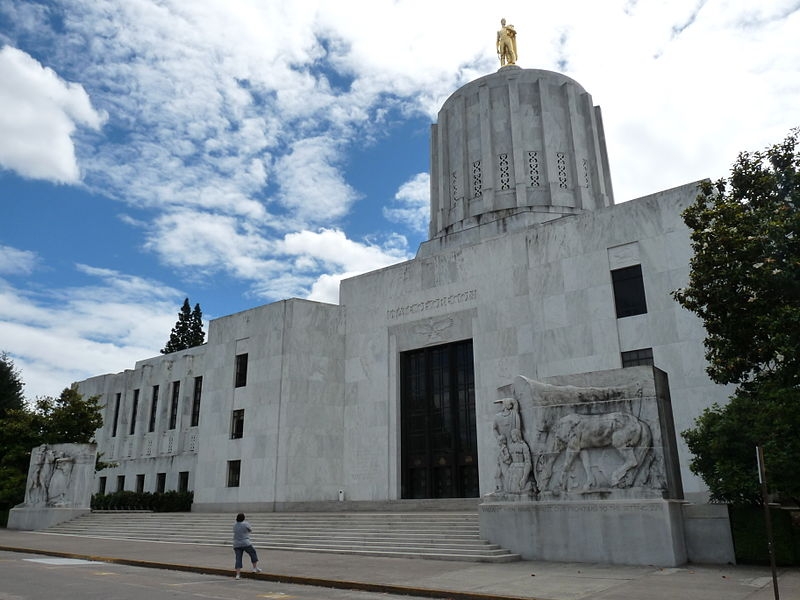As the 2018 legislative session grows closer, we zero in on the key policy debates.
A few complex policy issues are expected to take center stage during the 35-day legislative session that starts in February, but the short time frame makes resolution of the state’s big challenges unlikely.
“Short sessions are hard,” says Mike Freese, a lobbyist with the Romain Group. “Things happen fast. Unless there’s a lot of information and solid policy formation, it’s hard to get much done.”
Kyle Thomas, director of legislative and policy affairs for the Higher Education Coordinating Commission, says the state agency doesn’t plan to introduce any complex initiatives this session. Instead, HECC is focusing its attention on 2019.
Vacuums in key leadership positions present an obstacle to preparations for the brief session.
The departure of Sen. Richard Devlin, chair of the ways and means committee, left what CFM Strategic Communications lobbyist Dale Penn calls “a massive hole in power” leading up to a tense budget discussion. Devlin’s position was filled on Wednesday by Sen. Peter Courtney, D-Salem.
Other key legislators have departed for new jobs, including Rep. Mark Johnson who now heads the statewide business organization formed last year, Oregon Business and Industry.
Despite the obstacles, a few significant issues are attracting attention for the 2018 session. Here are three top priorities.
Budget Crisis/PERS reform
The state budget crisis looms large, but it’s unlikely legislators will reach a solution this session. During the recent Oregon Leadership Summit, Johnson, Gov. Kate Brown and other business and political leaders called for convening stakeholders, but they didn’t provide specifics about what they would discuss.
“There do not seem to be any plans in place on how to address it (the budget crisis),” Freese says. “The legislature wants to push it off until 2019, but lots of interests want action now.”
Related Story: On the Scene: Oregon Leadership Summit
A task force convened by Gov. Brown developed a few possible solutions, including privatizing state agencies like the OLCC, Freese says, but he believes most of the options are politically infeasible for the upcoming session.
The Public Employees Retirement System (PERS) will, yet again, be a flashpoint of the budget debate. Schools, municipalities and other public employers face increasing payouts that consume ever-larger chunks of their budgets. SEIU, the state’s largest public employees union, and others argue that lowering payouts would drastically cut retirement funds for state employees.
Measure 101
This measure is tied to a provision in the Affordable Care Act, which lowered federal funding to state Medicaid programs from 100% to 95% in 2017. During the spring 2017 session, Oregon legislators passed HB 2391, a health care tax, to make up for this gap in funding.
Measure 101 is a response to the health care tax. A “no” vote on this measure would repeal the 1.5% levy on healthcare insurance premiums.
Opponents of the tax, led by the Cascade Policy Institute and the Taxpayer Association of Oregon, say repeal would force legislators to find creative ways to cut costs from government programs. They also argue the tax is unfair—small business, healthcare providers and college students would pay, while unions, corporations and insurance companies would not. Instead of paying the tax themselves, insurance companies would pass the cost onto consumers.
Supports say repeal could endanger funding for Medicaid. Some 350,000 recipients, Measure they say, could lose healthcare coverage.
Repealing the tax would also blow a hole in the 2017-19 state budget of $210 million to $320 million, according to the measure’s fiscal impact statement, which would dramatically change the discussion over the budget crisis and PERS reform.
“A lot of what this session looks like will hinge on whether the referendum is successful,” Freese says.
If the measure fails, a host of state programs could face budget shortfalls, not just Medicaid, Thomas said, including state universities and state financial aid.
“We’re treating February differently than we usually would,” says Melissa Unger, Political Director at SEIU Oregon, She says the measure has a good chance of passing, but the union is planning for the worst.
“If Measure 101 doesn’t pass we have to tweak our priorities,” she said. The whole session will be about budget if it doesn’t pass.”
Cap & Invest
The Democrats are moving ahead with another effort to put a price on carbon. Their $1.4 billion carbon pricing plan would cap emissions from electricity, natural gas and transportation. Companies could comply with the cap through “offset projects” that reduce forestry and agriculture emissions, or buy allowances to pollute at higher levels.
The proposal still has a lot of kinks to work out under pressure in the short session. Nevertheless, an August memo from Ruchi Sadhir, advisor to Gov. Brown, notes “there is strong interest in pursuing its passage in the short 2018 session.”
Workgroups are currently hammering out answers to the 18 questions outlined in the memo, including how the policy will affect forestry and agriculture, investment opportunities in highly impacted communities and what state agency will take the lead in implementing the policy.
“2018 is a really challenging time to pass this comprehensive of a package,” says Penn, “but the governor is really interested in doing that.”
Penn says the Governor’s office would like to approach the bill in the same way it did HB 2017, the state transportation package. While that bill was applauded as an example of bipartisanship, however, Penn said cap & invest lacks any Republican support.
The House and Senate also each have different versions of the bill, Freese says, that they will have to reconcile quickly.
“Legislators are working on a bill none of us have seen yet,” he says. “It’ll be difficult to pass in a short session.”
If the bill does pass, it would raise revenue from gas and electric utilities that could shrink the budget deficit, or pay for infrastructure in rural areas.
Other Issues
Harassment Policies
In the wake of sexual harassment allegations against Sen. Jeff Kruse, the legislature is getting serious about updating its training policies. There doesn’t seem to be any specific discussion, however, about what the new approach would look like.
“The attention that is on this issue will continue,” Penn says. “But I don’t know what’s going to happen.”
Paid Family Leave
Calling it a necessary benefit widely adopted in other developed countries, Democrats are advancing HB 3087, which would give Oregon employees up to 12 weeks of paid leave to care for themselves or family members. While unions like SEIU support the bill, business leaders are pushing back.
“Small businesses are still adjusting to minimum wage increases,” said Jason Brandt, CEO of the Oregon Restaurant and Lodging Association, which wants to push off the leave discussion until the 2019 session. “Let’s give them time before we add to labor regulations.”
Impact of federal legislation
Some federal legislation currently in flux could prompt changes in state policies.
Oregon ties its state tax code to federal policy, so the final form of the Republican federal legislation, released last Friday, could spell big changes for Oregon. Corporations might reorganize under different designations (i.e. C-corp, S-corp) to take advantage of the new rules.
An overhaul of federal financial aid for higher education, recently finalized by Republicans, would end the practice of indexing Pell Grants to inflation, and end some protections for students attending for-profit colleges.
Oregon legislators, Thomas says, could make technical changes to state policies to continue these protections.
“The legislative would want to make sure students don’t lose ground and have protection in for-profit colleges,” he said.






